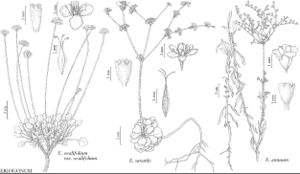Eriogonum saxatile
Proc. Amer. Acad. Arts 12: 267. 1877.
Herbs, loosely to densely matted, not scapose, (1–) 2–4 × 0.5–2 dm, densely white or grayish-lanate to tomentose or floccose. Stems spreading, often with persistent leaf-bases, up to 1/4 height of plant; caudex stems matted, decumbent to spreading; aerial flowering-stems spreading to erect, slender, solid, not fistulose, 0.5–1.5 dm, lanate to tomentose or floccose. Leaves basal or sheathing up stems 4 cm, 1 per node or fasciculate at tips of caudex branches; proximal leaves: petiole 1–3 (–4) cm, tomentose, blade obovate to rounded, 1–2 (–2.5) × 1–2 cm, lanate to tomentose; distal leaves sessile, blade elliptic to rounded, 0.3–1 × 0.3–1 cm, lanate to tomentose. Inflorescences cymose, 10–25 × 5–12 cm; branches dichotomous, lanate to tomentose or floccose; bracts 3–4, scalelike, triangular, 1.5–7 mm. Peduncles absent. Involucres 1 per node, turbinate, 3–4 × 2–3 mm, tomentose to floccose; teeth 5–6, erect, 0.8–1.5 mm. Flowers (3–) 5–7 mm, including elongate, sharply triangular, slightly winged, stipelike base; perianth white to rose or yellowish, glabrous; tepals connate proximally, dimorphic, those of outer whorl oblanceolate to lanceolate, 3–5 × 1.5–2 mm, those of inner whorl obovate, 4–6 × 2–3 mm; stamens included to slightly exserted, 2.5–5 mm; filaments pilose proximally. Achenes 3-gonous, nearly winged, 3.5–4 mm, glabrous. 2n = 40.
Phenology: Flowering May–Oct.
Habitat: Decomposed granitic or volcanic flats, slopes, and ridges, chaparral, saltbush, and sagebrush communities, pinyon-juniper and montane conifer woodlands
Elevation: (300-)800-3400(-3500) m
Discussion
Eriogonum saxatile is found mainly in arid mountains of California (Fresno, Inyo, Kern, Los Angeles, Mono, Monterey, Riverside, San Benito, San Bernardino, Santa Barbara, Tulare, and Ventura counties) and Nevada (Esmeralda and western Nye counties). The plants vary considerably as to robustness, degree of branching, and sprawl of the caudex. The size and position of the leaves also vary, as does the density of tomentum on the blades. Flower color varies from white to rose or yellowish, but the deep yellow of E. crocatum is never seen in E. saxatile. The species is frequently cultivated and is an excellent plant for the rock garden.
Selected References
None.
Lower Taxa
"/2" is not declared as a valid unit of measurement for this property."dm" is not declared as a valid unit of measurement for this property."dm" is not declared as a valid unit of measurement for this property.

